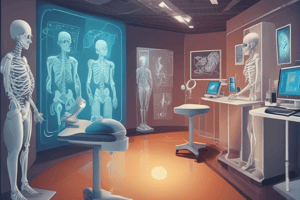Podcast
Questions and Answers
What does high contrast in radiography refer to?
What does high contrast in radiography refer to?
- A digital histogram
- A static image
- Few gray tones with a higher difference between densities (correct)
- Many shades of gray
Low contrast images have a narrow exposure latitude.
Low contrast images have a narrow exposure latitude.
False (B)
What is the primary function of contrast in radiography?
What is the primary function of contrast in radiography?
To make the detail visible
The computer uses a technique called _______ to correct exposure areas in digital radiography.
The computer uses a technique called _______ to correct exposure areas in digital radiography.
Match the following terms with their definitions:
Match the following terms with their definitions:
Which of the following is NOT a radiographic quality?
Which of the following is NOT a radiographic quality?
Before digital radiography, images were static and could not be manipulated post-processing.
Before digital radiography, images were static and could not be manipulated post-processing.
What is a LUT in digital radiography?
What is a LUT in digital radiography?
What is the primary controlling factor for subject contrast?
What is the primary controlling factor for subject contrast?
The Look Up Table (LUT) can be altered by moving the area of focus.
The Look Up Table (LUT) can be altered by moving the area of focus.
What does a narrow window width in windowing lead to regarding contrast?
What does a narrow window width in windowing lead to regarding contrast?
The differential absorption of tissues affects the overall __________ in radiography.
The differential absorption of tissues affects the overall __________ in radiography.
What relationship exists between window width and contrast?
What relationship exists between window width and contrast?
Match the following terms with their definitions:
Match the following terms with their definitions:
Subject contrast can be manipulated with post-processing techniques.
Subject contrast can be manipulated with post-processing techniques.
What happens to the energy of photons when the kVp is increased?
What happens to the energy of photons when the kVp is increased?
Flashcards are hidden until you start studying
Study Notes
Radiographic Contrast
- The difference between two or more densities or receptor exposures (REs)
- Makes detail visible
- Higher contrast = more black and white, few shades of gray
- Lower contrast = more shades of gray, less black and white
- Both images have the same RE but different contrast
High Contrast
- Short scale or increased contrast
- Narrow exposure latitude (less margin for error)
Low Contrast
- Long scale or decreased contrast
- Wide exposure latitude (more margin for error)
Factors In Controlling Contrast
- The computer controls contrast in digital radiography by making changes as needed
- Digital radiography
- X-rays strike the image receptor (IR)
- X-rays are converted to electronic signals and sent to the computer
- The computer creates a digital histogram (raw data)
- The appropriate look up table (LUT) is selected for processing
- The computer combines the LUT with the existing histogram and corrects exposure areas
- This is called automatic rescaling
- Each pixel is part of a matrix that can be manipulated for brightness and contrast
- Each pixel changes its brightness and contrast in post-processing because of bit depth
Histogram & LUT
- Assesses the range and quantity of image receptor exposures in the image matrix
- The LUT is applied to the data
- Provides the proper grayscale for display
- The amount of data is controlled by exposure
- The detector cannot discriminate whether the exposure was kVp or mAs
- The only thing that matters is the exposure to pixels.
Windowing (Post Processing)
- Window width controls contrast expansion or compression
- Narrow window = increased contrast
- Wide window = decreased contrast
Subject Contrast
- This is the range of differences in the intensity of the x-ray beam after it has been attenuated by the patient
- Cannot be manipulated with post-processing, it is directly influenced by tissue attenuation
Differential Absorption
- The characteristics that make a radiograph unique
- Controlled by subject contrast
- Different tissues absorb differently depending on patient size and shape
Kilovoltage Peak (kVp)
- The primary controlling factor for subject contrast
- Inverse relationship exists between kVp and subject contrast
- High kVp:
- Results in low or long scale contrast
- More shades of gray
- Low kVp:
- Results in high or short scale contrast
- Fewer shades of gray
Studying That Suits You
Use AI to generate personalized quizzes and flashcards to suit your learning preferences.


